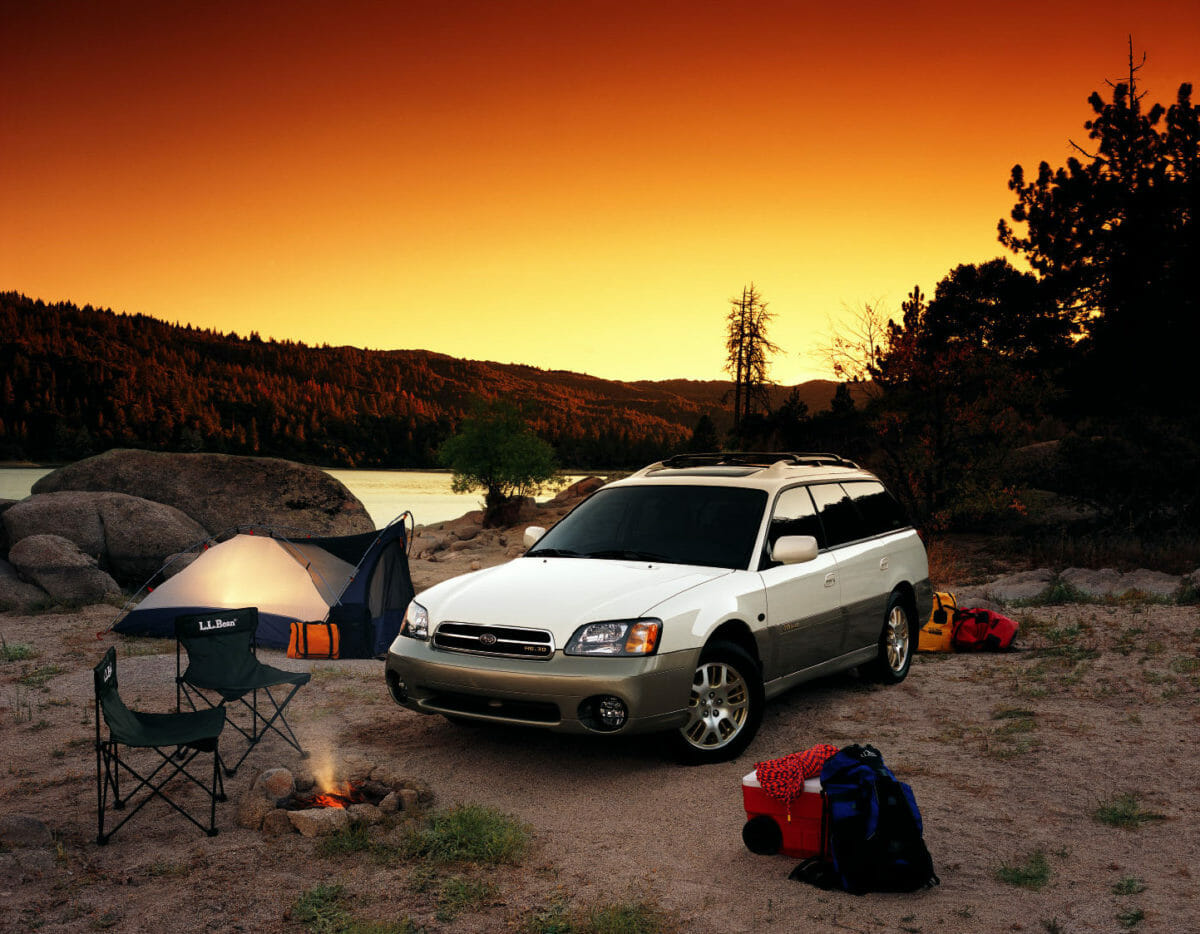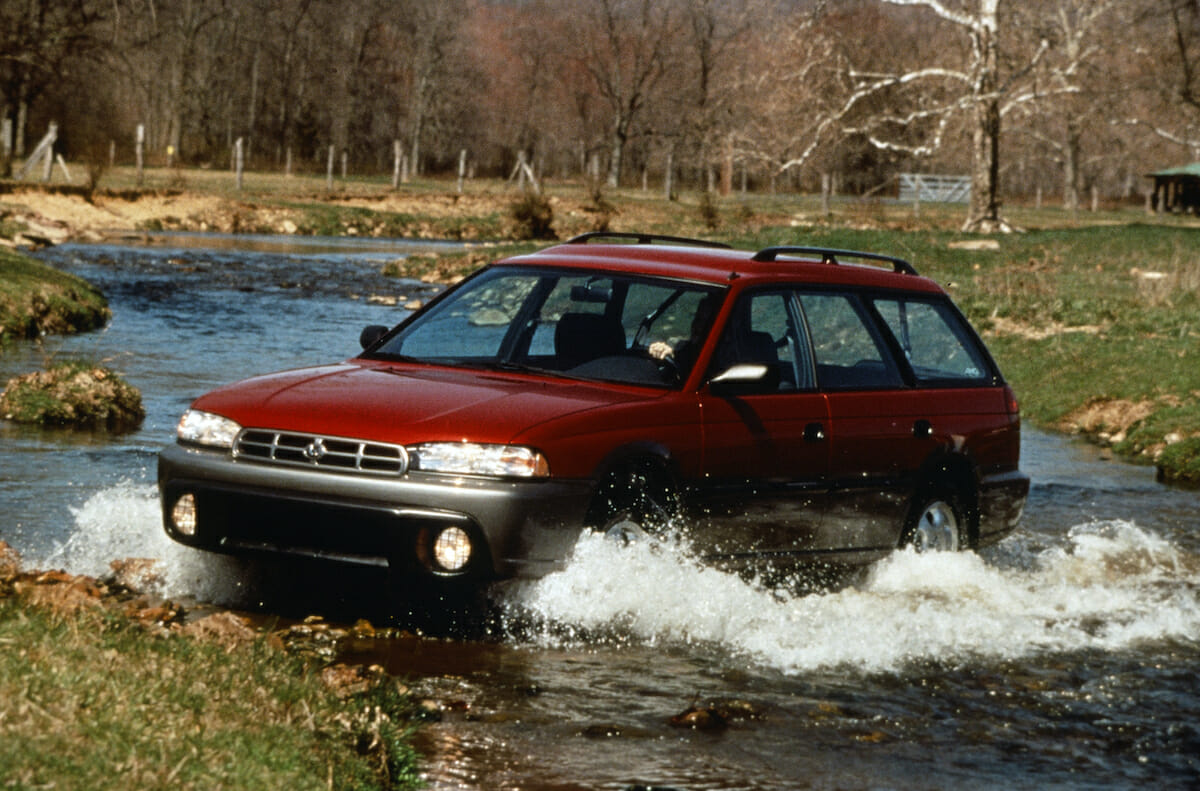Subaru’s boxer engine extends back to the 1960s & carries a rich heritage. Here’s what to look for when considering buying a new or pre-owned Subaru.

Have you ever been walking down the street enthralled in your own thoughts, taking in the cool morning breeze and pondering life’s many questions only to be interrupted by the defined putter of a car engine? The exhaust note making it sound broken?
The seven sisters on the badge and the car shrouded in WR Blue Pearl? You have just encountered Subaru‘s trademark. Whether you call it a flat-four, H4, a boxer, or otherwise, there’s a lot of charm stuffed under the hood of most Subarus, but the story starts a little further back.
Subaru: A Brief History
In 1897, over 50 years before Subaru was launched, Karl Benz invented the flat two-piston engine that spun a centric driveshaft pumping out five horsepower. Benz would go on to be the secondary namesake in a popular German luxury brand–Mercedes-Benz–and increase the horsepower in the flat two by 300% by 1902.
It started there, but what is it? A horizontally opposed engine often identified by “H” and then the number of cylinders (i.e. H4), it is an engine that operates with cylinders laying flat and parallel to the ground. The cylinders spin a driveshaft in the middle of the cylinders, and in a four-cylinder variant, the cylinders will fire on opposing corners, which is what gives the engine a distinct two-stroke sound despite being in four-stroke combustion set up. These engines were used in everything from aircraft to World Rally Cars. More on rally cars later.
Subaru produced an air-cooled 1.5L flat-four in its prototype, the Subaru 1500. But Fuji Heavy Industries didn’t figure this was worth a gamble on a production car. So, the 1500 stayed a prototype. Three years after that, and almost 70 years after Benz, Subaru introduced its second attempt at flat-churning madness in the Subaru 1000, with a 923CC, water-cooled, horizontally opposed four-cylinder. By 1965, Japanese consumers were laying their eyes on an engine that would change the world.
Subaru would stuff the EA-Engine into vehicle applications from the 1960s into the early 1990s and eventually start turbocharging it to eke out more power. From the first production iteration of the Subaru 1000, the EA-Engine could be found in many other cars, like the FF1, Van 1200 Standard, Brat, and Leone, to name a few. At its peak, the EA platform would only make 115 horsepower in the EA-82T, and in 1994, Subaru moved on to bigger and better things.
The Engine Heard Around the World
By the early 1990s, people were turning their noses up at grunge rock and trying to hold onto the last few semblances of the 1980s. The progress of cars was no different, and like all things, it was consumer-driven. One thing that was changing at Subaru was powertrains. These pivotal years began to shape Subaru into the powerhouse that it is today.
While Subaru was settling itself into World Rally, it became the second car company (after Audi’s Quattro) to successfully combine its engines with a four-wheel-drive system.
In 1995, Colin McRae won the FIA World Rally Championship in an iconic Subaru Impreza 22B with a performance modified EJ22G that makes a base 280 horsepower.
This was Subaru’s ticket to world fandom, and what pushed a lot of young car enthusiasts to put pan-blurred posters of rally cars on their walls instead of standard choices like Lamborghinis. The EJ platform and Subaru’s ever-developing all-wheel-drive would become an inseparable combination that appeared in multiple vehicles in the years to come, namely the Subaru Impreza, Legacy, and the Forester.

G’day, EJ: The EJ Engine Versatility
While McRae and Petter Solberg were thrashing Subaru Tecnica International (STI) Subarus around rally tracks across the world, Subaru made moves to capture a totally different demographic of the auto market. The introduction of the Subaru Outback was in 1995 and it sported a tamer version of the EJ22 engine, showing that the cross-capable applications for this boxer four were nearly all-inclusive.
Pushing the new hatch on consumers, Subaru dubbed the Outback as the world’s first sport-utility wagon –– complete with an advertising campaign starring none other than “Crocodile Dundee” himself, Paul Hogan. The popular Aussie actor told Subaru: “You better be able to build a lot of these because I’m going to sell the hell out of them.”
The EJ engine platform went in every single Outback until a fourth-generation refresh in 2013. The first press event for the Outback was set in central California, where it was put through a rigorous off-road demonstration.
Ultimately prevailing and being hailed as a fully-capable sport utility wagon, the outdoors-loving consumers began to flock to Subaru’s offering of the Outback.
Engine Woes: Black Coolant & White Exhaust
The well-established Japanese manufacturer hadn’t made it this far without having some issues of its own. In a lot of ways, just as they’re famous for all the things above, they’re also famous for head gasket issues. Whether you just call it a blown head gasket or a “leaking” head gasket, the fate is the same.
The problem originated in the early 1990s and was most prevalent in Subaru’s 2.5L EJ25 engine, and it plagued the Impreza, Outback, Forester, Legacy, and Baja. The problem would persist for the next decade, severely damaging Subaru’s loyal consumer base. Because of the orientation of a flat-four engine, with the pistons moving more or less parallel to the ground, the internal fluids have a propensity to naturally pool around the head gasket.
With engine fluids having an acidic makeup, naturally, the seals that keep fluid in the engine begin to break down and erode. This failure gave buyers tell-tale signs — like an oily residue in the coolant reservoir, and in some cases, black coolant caused by oil that was transmitted from the engine.
Additionally, consumers would notice white smoke from the exhaust, which signified that coolant was being burned in the cylinders. All this added up to fluids not performing their correct and essential functions and causing engine-damaging overheating.
While there were preventative measures to keep failures at bay, they often didn’t fit in the average car owner’s basic understanding. Changing the oil is normal, but it was recommended to change your coolant more frequently to prevent it from becoming corrosive and more hazardous to your precious fluid seals in the engine. It has all the makings of an overly sales-oriented service writer, trying to sell you something you don’t think you need.
While the seriousness of the issue shouldn’t be minimalized, the engine would perform without issue for 100,000 to 150,000 miles before failing with replacement head gaskets lasting a similar age –– provided that maintenance was similar for both.
With Honda and Toyota’s competitor vehicles lasting that many miles and longer without major engine troubles, coupled with a pursuit of higher mpg, it’s not hard to see why consumers would choose the less-finicky Japanese manufacturers.

Subaru’s Past & Future Engine Innovations
When you choose a vehicle, you choose it with your emotions –– whether you see it or not. We all have those conversations with ourselves about making a smart decision and removing emotion from purchasing a needed automobile before we go into the dealer. The reality is, somewhere between the extremes of emotional and stoic, we ended up at that dealer because of that car we like. We shop with our hearts. We want to like what we drive.
There is a loyal consumer-base of Subaru owners that lean into this at another level. The engines have had their problems but they stuck with a flat-four design when other auto manufacturers were moving to inline fours. Subaru chose to perfect a truly remarkable and aged aircraft engine with meticulous effort, and that translated into their automobiles. With the context given here, it’s hard not to be a fan of what they’re doing.
Since 2006, Subaru has been the most successful Japanese manufacturer by stats, increasing its annual sales 3.5 times from 200,000 to 700,000, breaking their own records from 2009 to 2019.
Today, every model they sell has a boxer-four cylinder engine option, and with the new boxer engines coming, they don’t show any signs of stopping. If something isn’t broken, why fix it? Right?
Photos: Subaru; DepositPhotos
